Few neighborhoods exemplify Brownstone Brooklyn like Park Slope. The area’s cafe-lined commercial corridors and rowhouse-lined side streets slope up to Brooklyn’s crown jewel, Prospect Park. It is famous for being a bastion of wealthy liberal politics, and its homes often sell for many millions of dollars. While Park Slope has few specific tourist attractions, it’s a great place to spend an afternoon and experience one of my favorite urban neighborhoods in the world.
Park Slope abuts a number of other areas that are worth including in a visit to the area. Gowanus, a long-time industrial area built around a (heavily polluted) canal, is now the site of rapid development, with breweries filling its old warehouses; past Gowanus is Red Hook, covered in another article. Just south of Park Slope is Green Wood Cemetery, a beautifully landscaped space that holds the graves of many prominent 19th century Brooklyn residents.
What to do in Park Slope
While a few subway lines go directly into Park Slope, there’s a good chance you will end up at Atlantic Avenue-Barclays Center, one of the largest transit interchanges in the city. At the very northwest corner of Park Slope and surrounded by traffic-choked thoroughfares, the area is not the most pleasant, but it is full of pedestrians at all hours, and a number of destinations are nearby.
On the east side of the intersection is Barclays Center, home to the Brooklyn Nets. Controversially built using eminent domain to condemn existing residential buildings as “blight,” the arena now anchors a huge housing development that extends over the railyards of the Long Island Railroad’s Atlantic Terminal.
Flatbush Avenue, heading southeast from Barclays towards Grand Army Plaza, divides Prospect Heights to the north from Park Slope to the south. Although it is wide and noisy, great restaurants, cafes, and bars line Flatbush and the side streets just around the corner. Pecking House, at the southwest corner of Flatbush and St. Marks Avenue, started as a pop-up with a ten thousand-person waiting list during the pandemic and serves Chinese-inflected fried chicken sandwiches that people line up for. Across the street is Sofreh, a popular upscale Persian restaurant.
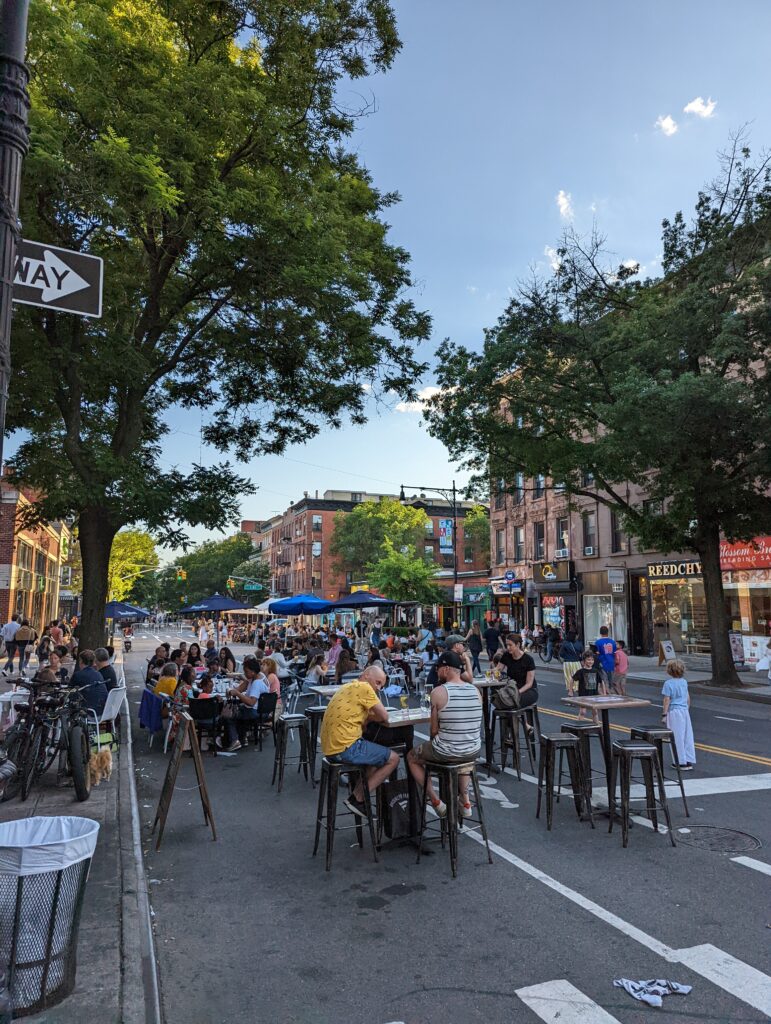
Heading south from Flatbush, each of Park Slope’s avenues has a different character. Fifth and Seventh Avenues are both delightful neighborhood commercial corridors lined with small, independent businesses all the way from Flatbush down to the southern edge of the neighborhood. Fifth is closed to traffic on Saturdays in the summer, creating a festival atmosphere. Sixth Avenue is quiet, leafy, and mostly residential, dotted with small cafes and restaurants every few blocks. Eighth Avenue is a more highly trafficked residential one-way street, as is Prospect Park West, which is lined with impressive architecture (and holds a protected bike lane vociferously opposed by the spouse of one of the street’s most prominent residents).
The narrow east-west streets contain the quintessential Park Slope scenes: elegant 19th-century brownstone rowhouses and small apartment buildings behind leafy trees that bloom with flowers in the spring. One of my favorites of these is Third Street, which is wider than the others (a relic of when it linked a local mansion with the Gowanus Canal in the 1850s before the rest of the neighborhood developed). That extra width is allocated to the sidewalks rather than traffic lanes, making it particularly enjoyable to walk up.
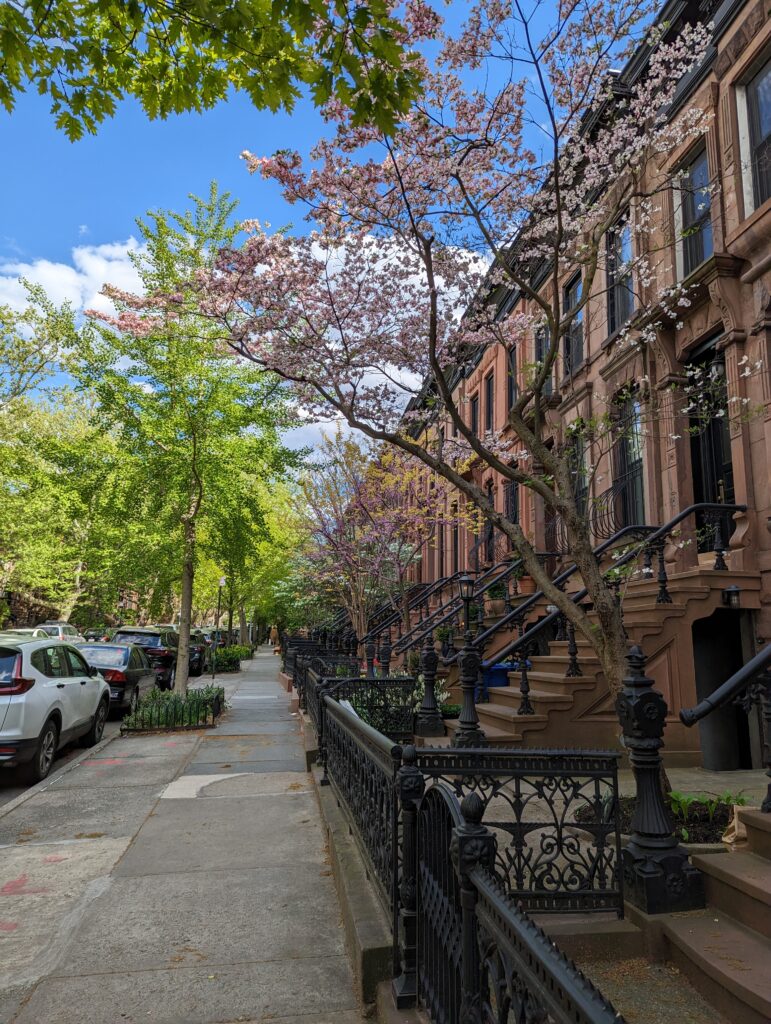
While Park Slope has a sleepy reputation, restaurants and bars in the area attract people from across the borough. Towards the north end of Fifth Avenue, Miriam serves inventive Israeli brunch and Bricolage has fantastic modern Vietnamese food. Farther south, Masalawala & Sons, with its Bengali cuisine, has been named one of the hardest reservations to get in the city. Stella’s, on Ninth Street, is a great option for Caribbean food. Among the neighborhood’s countless Italian restaurants, Pasta Louise stands out, serving a single shape of homemade pasta each day (Al Di La is great for a more extensive Italian menu). Owl Farm and Brewer’s Row are among the city’s best craft beer bars, and DDT is a quirky pro wrestling-themed bar on Union Street that plays WWE on its TVs.
The Old Stone House on Fifth Avenue is a reminder of the long history of the neighborhood. A restoration of a Dutch colonial farmhouse from around the turn of the 18th century, the house was the site of the Battle of Brooklyn during the Revolutionary War in 1776. The Brooklyn Dodgers played in a field next door in the late 1800s, and the house served as their clubhouse. Today, the house hosts art exhibits and educational events for students. The surrounding J.J. Byrne Park is full of children (more than a few of them with their nannies) each day, and a lovely farmers market sets up on the adjacent Fourth Street Plaza on Sundays.
The southeastern end of Park Slope morphs into Windsor Terrace, another area of brownstones adjacent to the park. At the corner of Prospect Park West and 14th Street, around where the neighborhoods meet, is the Nitehawk, a local movie theater that serves food and drinks to your seat and holds special showings of old or independent films along with first runs. South of there, Prospect Park West turns into the main commercial corridor of Windsor Terrace. Krupa Grocery is a restaurant that will put together a picnic basket for you to take into the park. SYKO serves a curious mix of Syrian and Korean dishes.
Prospect Park
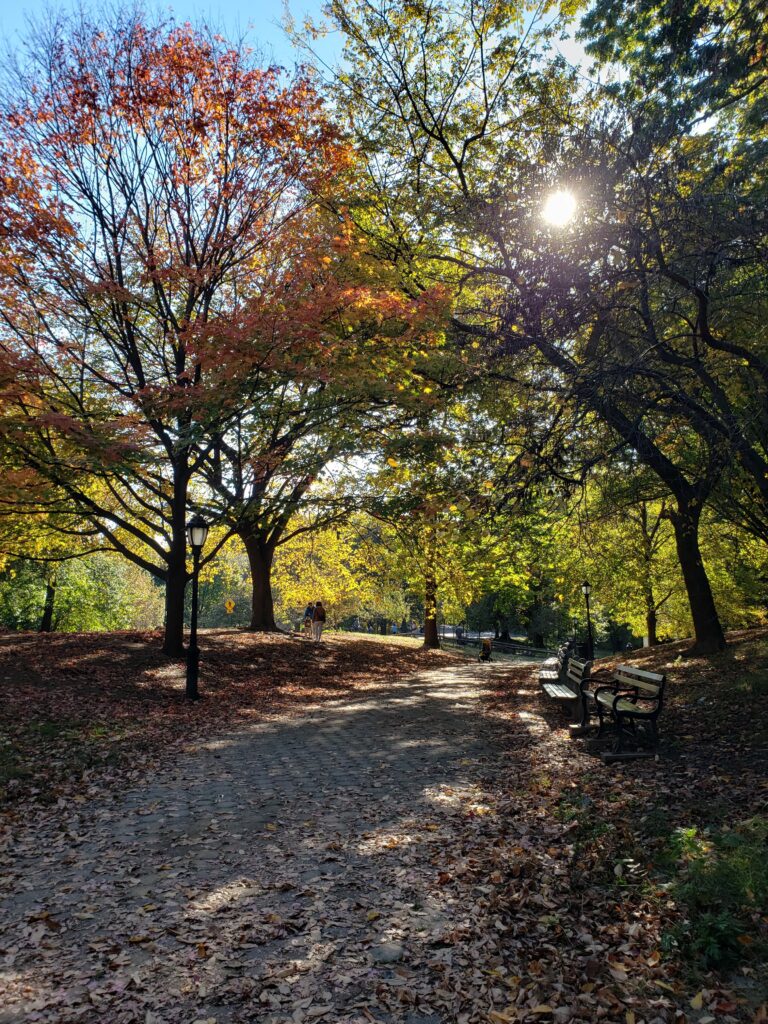
Walk east up any street in Park Slope and you will arrive at Prospect Park. One of the largest parks in the city, Prospect Park was designed by Frederick Law Olmsted and Calvert Vaux just after they designed Central Park. Prospect Park attracts far fewer tourists than its cousin in Manhattan, instead filling with locals, particularly on summer weekends.
At the northern tip of the park is Grand Army Plaza, which contains a triumphal arch dedicated to the Union’s victory in the Civil War in the middle of a huge traffic circle. The central branch of the Brooklyn Public Library is across the street, with a striking Art Deco exterior (the interior is less interesting). The south side of the intersection hosts one of the city’s largest farmers markets every Saturday year-round.
A three-mile-long road loops around the park, popular with bicyclists and joggers, particularly after it finally closed to traffic only a few years ago. Inside the loop are large open meadows, a lake, and dense forest. At the southeast corner of the park is the LeFrak Center, where you can go ice skating in the winter and rent a boat to go out on Prospect Park Lake in the summer.
If you didn’t pick up a picnic basket from Krupa Grocery, you can get sandwiches and baked goods from Winner, a popular bakery that has a location near the western edge of the park in addition to one on Seventh Avenue in the middle of Park Slope. On Sundays in the summer, a branch of the street food festival Smorgasburg sets up near the LeFrak Center, packed with people choosing from dozens of stands.
What to Do in Gowanus
If you go down the hill from Park Slope rather than up, you’ll end up in the Gowanus neighborhood. Built around the Gowanus Canal, the area has been industrial since the mid-19th century. As a result, the canal has been severely polluted, and it is now a Superfund site, with the EPA working to dredge up the top layer of polluted sediment then cap it with concrete to prevent further contamination into the water.
While that introduction may not make Gowanus sound very appealing, the neighborhood is in the midst of rapid change. As industrial uses have left New York City, art galleries and hip commercial businesses have moved in. The area has become somewhat of a brewery district, with several breweries within a few blocks of each other. Finback, which specializes in IPAs, and Wild East, which focuses on sours, are my favorites (and they each have plenty of variety beyond those styles). There are some great restaurants, too, like the seafood bar Littleneck (don’t worry, they’re not catching anything in the canal) and the fun Hawaiian restaurant SweetTalk.

Bridges cross the canal at Union, Third, and Ninth Streets and offer views of the towers of Downtown Brooklyn rising behind the canal and the remaining industrial buildings that still line it. Another bridge at Carroll Street is undergoing a long-term closure but is interesting from an engineering perspective – built in 1889, it is one of the last remaining retractable bridges in the United States, pulling the bridge sideways onto land to allow boats to pass rather than rising like a drawbridge.
Gowanus’s underused warehouses have attracted some unique space-intensive uses. One particularly popular spot is the Royal Palms Shuffleboard Club, where people reserve well in advance to get a drink and play shuffleboard in an almost clubby atmosphere. A few blocks away is Gotham Archery, where you can take archery lessons or rent a lane to shoot on your own. On the canal itself, the Gowanus Dredgers offer canoe rides (when the EPA permits it).
Further changes are on their way. The City recently rezoned the Gowanus area to allow high-rise residential development, with construction visible across the neighborhood. Developments along the canal are required to build out public space along the water, with the goal of eventually having continuous paths lining each side of the canal (and protecting the surrounding area from flooding during storms). The development on the west side of the canal just south of Carroll Street was one of the first to build out waterfront public space, along with the Whole Foods on the east side south of Third Street.
What to Do in South Slope/Greenwood Heights
As you go south from Park Slope, you get into the South Slope and Greenwood Heights neighborhoods. The area down here is a little less stodgy (and less expensive) than the central and northern parts of Park Slope, and there are still plenty of great restaurants, including many Mexican and Salvadoran places on Fifth Avenue. Sea Witch is a nautical-themed bar with a great beer selection that has an aquarium behind the bar and a koi pond in its landscaped backyard. Greenwood Park and Chilo’s are bars with big outdoor areas that are great for watching games or just hanging out in nice weather.
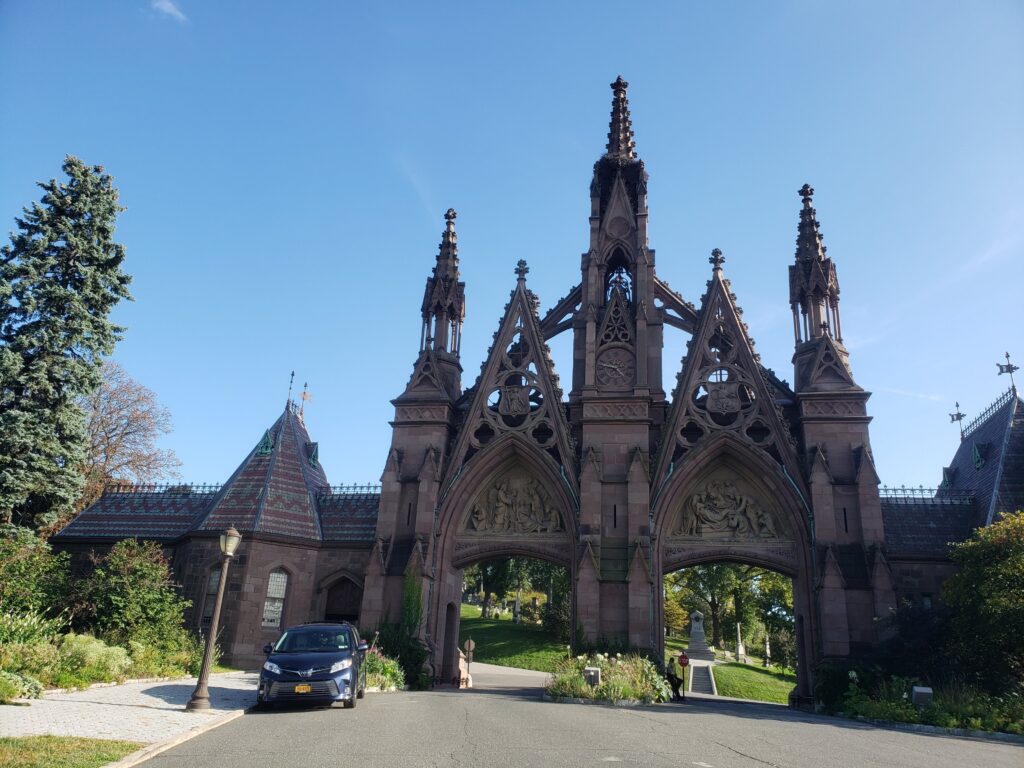
On Fifth Avenue and 25th Street, you arrive at the main entrance to Green-Wood Cemetery. The cemetery dates back to the 1830s, when the area was still rural, with beautiful landscapes and architecture. A huge Gothic gate stands at the entrance, and winding paths snake up the steep hill between trees and tombs. From higher parts of the cemetery, the Manhattan skyline is visible between the trees.
Famous people buried here include DeWitt Clinton, who built the Erie Canal as Governor of New York; Boss Tweed, who led the corrupt New York City political organization Tammany Hall in the late 1800s; decorative artist Louis Comfort Tiffany; and more recent artists like Jean-Michel Basquiat and Leonard Bernstein. The cemetery hosts periodic events, including (perhaps a bit morbidly) concerts in its catacombs.
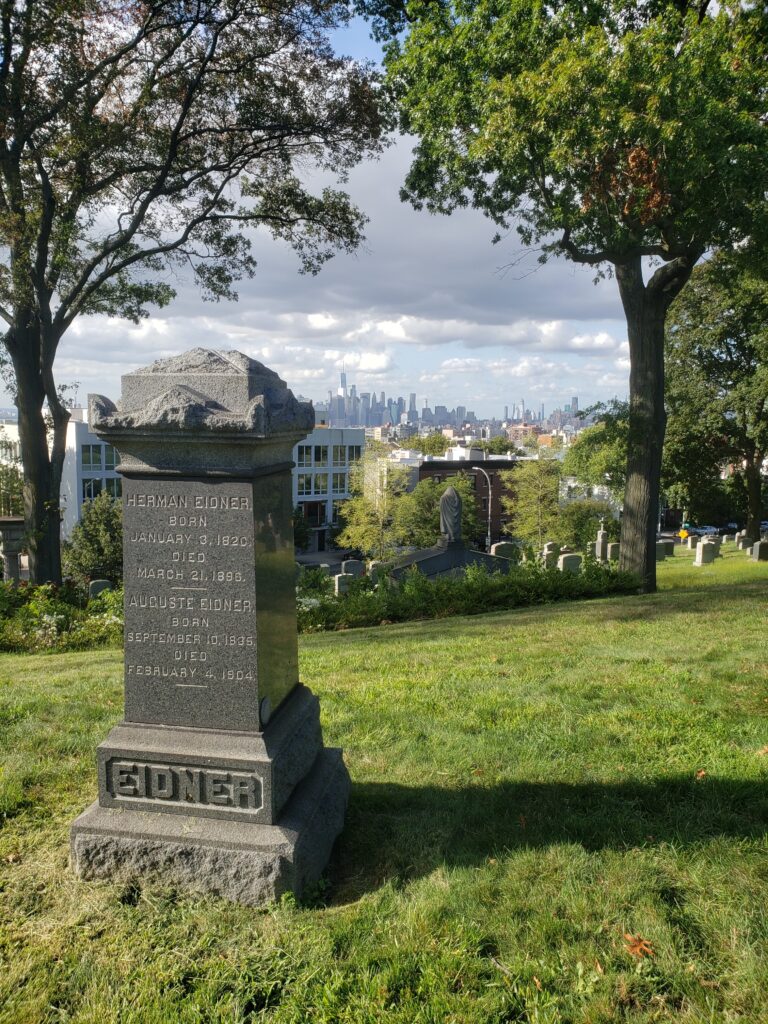
West of the cemetery towards the water is Industry City. A huge complex of old warehouses from the early 20th century, the area fell into disuse in the 1970s and has now been converted into a mix of commercial uses on the ground floor and small manufacturing spaces for local artisans above. Breweries and distilleries surround courtyards with art installations between the tall warehouses, and food halls and shops are inside the buildings. One building contains Japan Village, a Japanese grocery store and collection of food stalls.
To the south, Green-Wood Cemetery and the Greenwood Heights neighborhood abut Sunset Park, a diverse area that could be the subject of its own article. It contains a large Chinatown centered on Seventh and Eighth Avenues and a Latin American neighborhood around Fifth Avenue. The neighborhood’s namesake park is built on a steep hill with great views of Manhattan and the harbor.

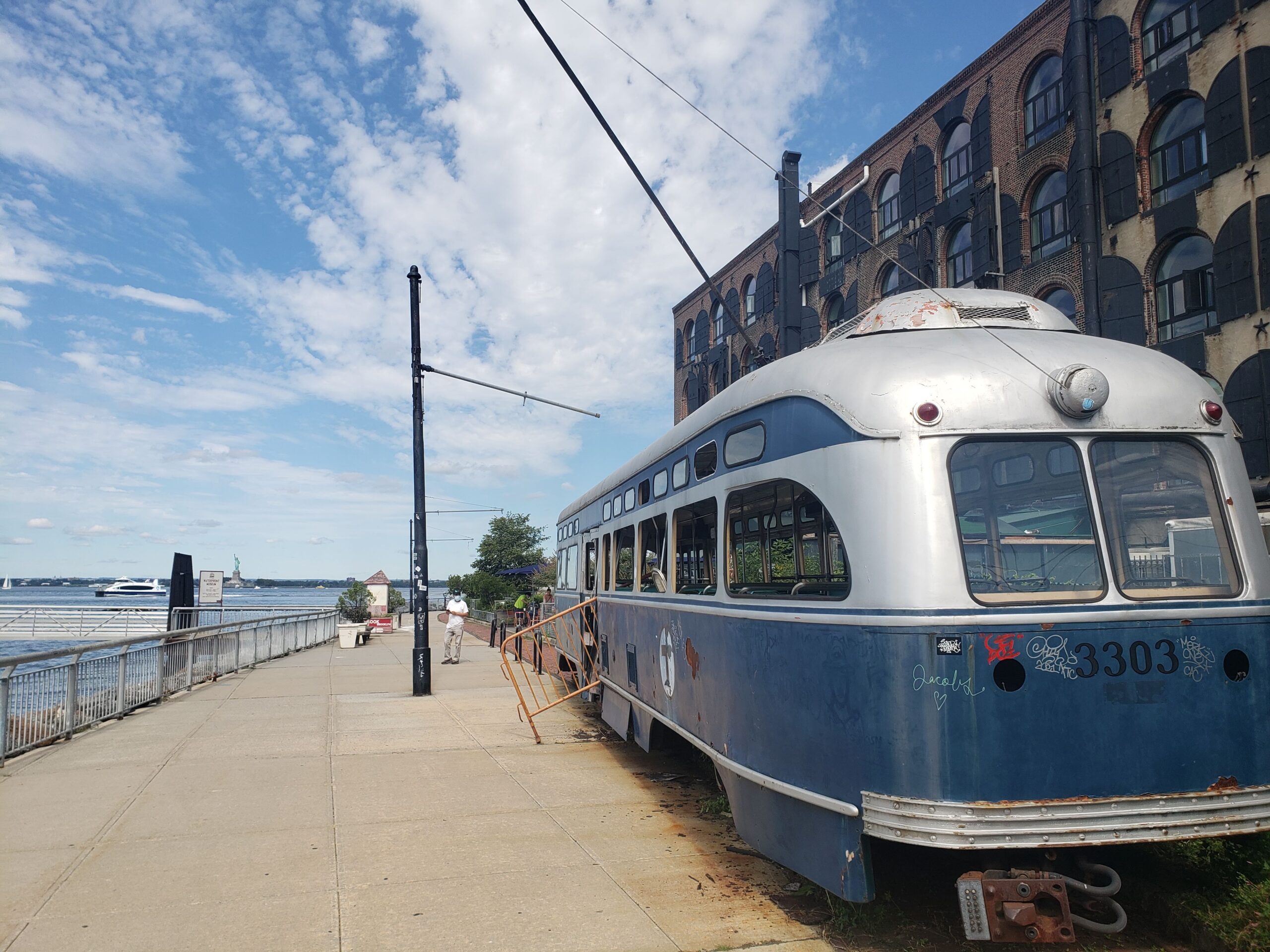

Add the RKO theater-turned supermarket + apartments! They’re a photo inside the market that shows the building as a theater.
Maybe some more info about the ethnic history of Park Slope?
Love this, Alex. What a thoughtful and informative thing to do!